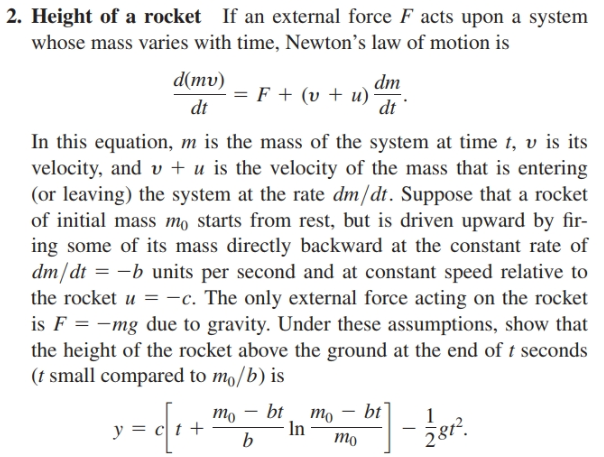2. Height of a rocket If an external force F acts upon a system whose mass varies with time, Newton's law of motion is d(mv) dm - = F + (v + u) dt dt In this equation, m is the mass of the system at time t, v is its velocity, and v + u is the velocity of the mass that is entering (or leaving) the system at the rate dm/dt. Suppose that a rocket of initial mass mo starts from rest, but is driven upward by fir- ing some of its mass directly backward at the constant rate of dm/dt = -b units per second and at constant speed relative to the rocket u =-c. The only external force acting on the rocket is F = -mg due to gravity. Under these assumptions, show that the height of the rocket above the ground at the end of t seconds (t small compared to mo/b) is то — bt, mo — bt In - žer. y = тo
2. Height of a rocket If an external force F acts upon a system whose mass varies with time, Newton's law of motion is d(mv) dm - = F + (v + u) dt dt In this equation, m is the mass of the system at time t, v is its velocity, and v + u is the velocity of the mass that is entering (or leaving) the system at the rate dm/dt. Suppose that a rocket of initial mass mo starts from rest, but is driven upward by fir- ing some of its mass directly backward at the constant rate of dm/dt = -b units per second and at constant speed relative to the rocket u =-c. The only external force acting on the rocket is F = -mg due to gravity. Under these assumptions, show that the height of the rocket above the ground at the end of t seconds (t small compared to mo/b) is то — bt, mo — bt In - žer. y = тo
Algebra & Trigonometry with Analytic Geometry
13th Edition
ISBN:9781133382119
Author:Swokowski
Publisher:Swokowski
Chapter2: Equations And Inequalities
Section2.7: More On Inequalities
Problem 44E
Related questions
Question

Transcribed Image Text:2. Height of a rocket If an external force F acts upon a system
whose mass varies with time, Newton's law of motion is
d(mv)
dm
- = F + (v + u)
dt
dt
In this equation, m is the mass of the system at time t, v is its
velocity, and v + u is the velocity of the mass that is entering
(or leaving) the system at the rate dm/dt. Suppose that a rocket
of initial mass mo starts from rest, but is driven upward by fir-
ing some of its mass directly backward at the constant rate of
dm/dt = -b units per second and at constant speed relative to
the rocket u =-c. The only external force acting on the rocket
is F = -mg due to gravity. Under these assumptions, show that
the height of the rocket above the ground at the end of t seconds
(t small compared to mo/b) is
то — bt, mo — bt
In
- žer.
y =
тo
Expert Solution
This question has been solved!
Explore an expertly crafted, step-by-step solution for a thorough understanding of key concepts.
This is a popular solution!
Trending now
This is a popular solution!
Step by step
Solved in 7 steps with 7 images

Recommended textbooks for you

Algebra & Trigonometry with Analytic Geometry
Algebra
ISBN:
9781133382119
Author:
Swokowski
Publisher:
Cengage

Algebra & Trigonometry with Analytic Geometry
Algebra
ISBN:
9781133382119
Author:
Swokowski
Publisher:
Cengage